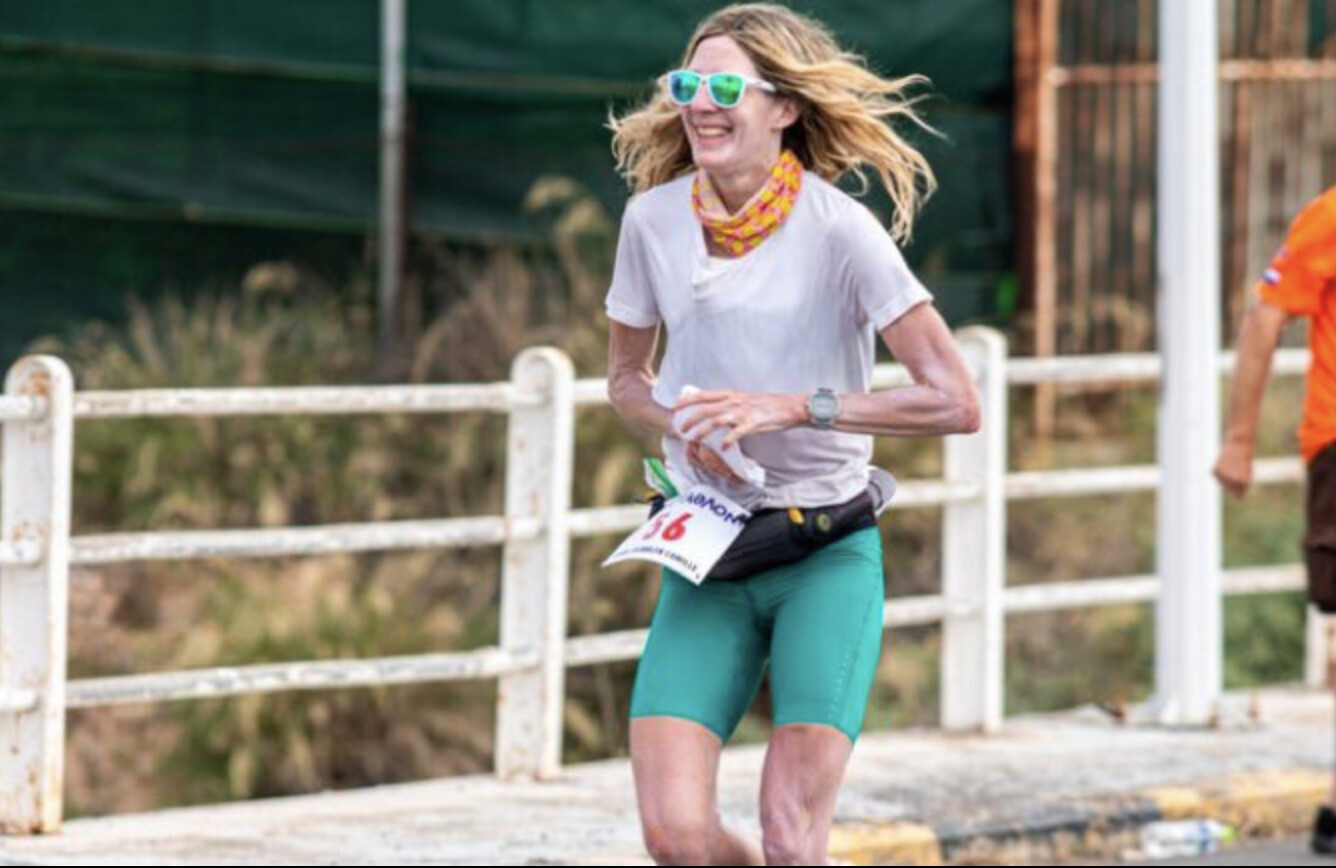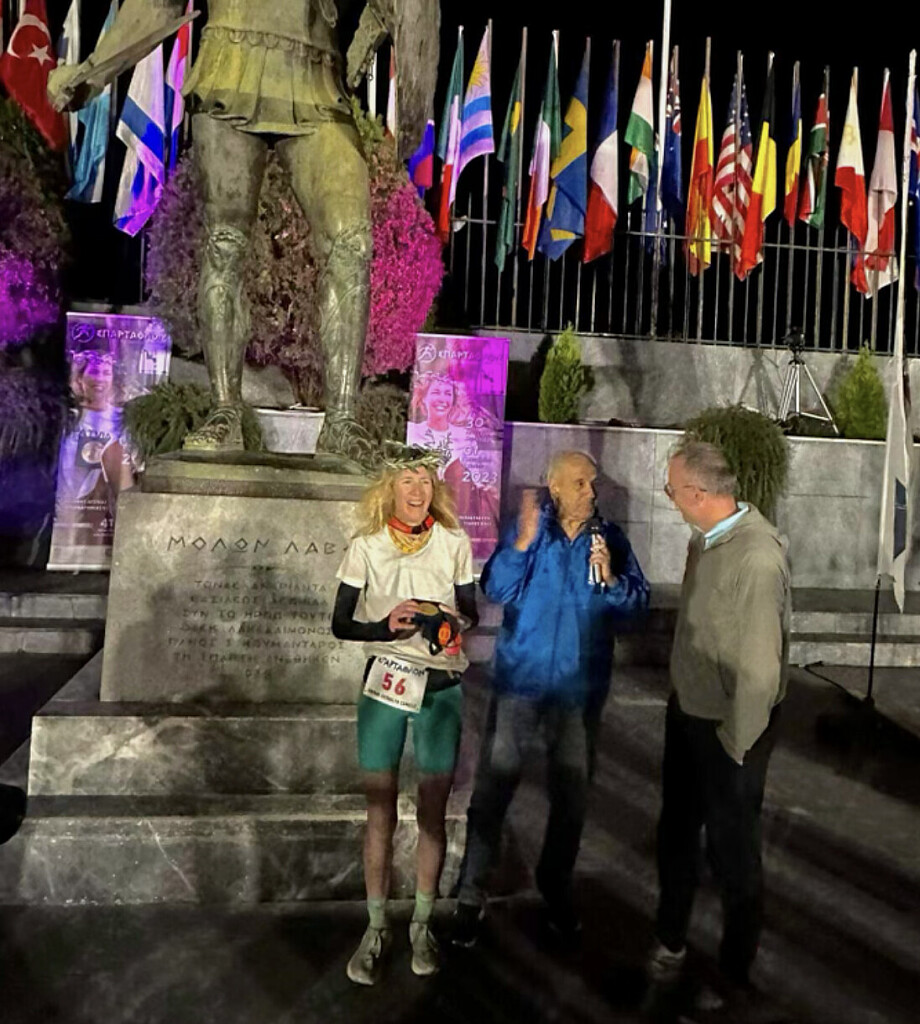Running News Daily
Running News Daily is edited by Bob Anderson. Send your news items to bob@mybestruns.com Advertising opportunities available. Train the Kenyan Way at KATA Kenya and Portugal owned and operated by Bob Anderson. Be sure to catch our movie A Long Run the movie KATA Running Camps and KATA Potato Farms - 31 now open in Kenya! https://kata.ke/
Index to Daily Posts · Sign Up For Updates · Run The World Feed
Armed with Smarts and Science, Camille Herron Sets an Astounding Record in Greece
The American ultrarunner credits patience and reduced carbohydrate intake to helping her smash the women’s course record in the Spartathlon, the iconic 153-mile race from Athens to Sparta
Camille Herron continues up to her usual record-breaking ways, smashing the women’s record at the 40th edition of the daunting Spartathlon ultra-distance running event in Greece on October 2.

Herron, a 41-year-old Lululemon-sponsored runner from Warr Acres, Oklahoma, covered the 153-mile course in 22 hours, 35 minutes and 30 seconds. She shaved more than two hours off the previous record and became the first woman to finish the course in under 24 hours in the 40-year history of the race.
Spartathlon was created in 1983 to send runners on a journey following the ancient route of Pheidippides, a courier who ran the distance between Athens and Sparta to seek military aid during a battle against the Persians in 490 B.C.. The modern-day race route includes flat roads and mountainous trails with more than 10,000 feet of elevation gain.
Incredibly, Herron averaged 8:55 mile pace, with her fastest mile clocking in at 6:28 (for the seventh mile).
“Wow, it was so much fun because we were running in the footsteps of Phidippides,” Herron says. “The whole time I was running, I was just trying to imagine what he did running on those ancient roads and paths. It’s a little different nowadays having cars and like all these things we have to dodge along the way. But it was incredible. I just loved the whole day because I love both road running and trail running and the course had big sections of each. To have a race that combined all of that, the process in my mind was all about a journey to a destination.”
Greek runner Fotis Zisimopoulos was the overall winner in 19:55:09, a new course record that broke the longstanding mark of 20:25:00 by ultrarunning legend Yiannis Kouros in 1984. Herron finished third overall behind Zisimopoulos and Norway’s Simen Holvik (22:35:31) and shattered the women’s record of 24:48:18 set by Poland’s Patrycja Bereznowska in 2018.

The Spartathlon course starts with a fast urban road section between Athens and Corinth—where dodging vehicles, traffic and pedestrians is necessary—before transitioning onto trails and meandering through vineyards and orchards before eventually going into the Geraneia Mountains. The final section of the course consists of downhill and flat road sections that lead to Sparta.
As she’s known to do, Herron started fast. But she was surprised to have five other women running seven-minute mile pace alongside her. She made a judgment call to slow down a bit, knowing she had a lot of running ahead of her and needed to save her legs.
“In my mind I’m thinking, ‘This is way too fast,’” Herron says. “I was worried we weren’t going to have our legs under us to hit the mountain section. So I ended up just backing off and let all of these women go. They were just hammering it. I was like, ‘Whoa, this is crazy!’ But at the same time, I was inspired by the other women in the race that they had the courage and the strength to go for it. I was like, ‘Hey, you go girl.’”
Finland’s Noora Honkala and Satu Lipiäinen were at the front, followed by Hungary’s Szvetlana Zétényi, Switzerland’s Stine Rex and Germany’s Sarah Mangler. They all wound up building 10- to 30-minute gaps on Herron. But when they entered the trail section with significant climbing, Herron tapped into her uphill abilities and started closing the deficits to the other women. Once back on the roads, she snapped back into her quintessential quick stride turnover and quickly made up the 12-minute gap to pass Lipiäinen, the second-place woman.
Out front, Honkala ran fast and pushed the pace the whole day. When she entered the mountain phase of the race, she had a 26-minute gap on Herron. But Herron’s relatively strong trail and downhill running abilities paid huge dividends, and with 20 more miles to go, she caught and passed Honkala. Herron surged the rest of the way, ultimately building a gap of more than 50 minutes on Honkala (23:23:03). Lipiäinen finished third (23:48:34), followed by Zétényi (27:57:49) and Rex (28:18:35) in what was the most competitive women’s race in the history of the event.
Herron continues to improve with age, especially in longer events. In February, she set multiple masters world records and U.S. records at the Raven 24-Hour race in South Carolina, running 150.43K (93.47 miles) in 12 hours, and then crossing the 100-mile mark in 12:52:50.
Then in March, Herron set a new women’s world record after logging 435.336K (or 270.505 miles) in 48 hours at the Sri Chinmoy 48-Hour Festival in Canberra, Australia. That mark not only broke the existing women’s 48-hour world record of 411.458K (255.668 miles) set by U.K. runner Joasia Zakrzewski, but it also surpassed the all-time American record of 421.939K (262.181 miles) previously set by Olivier LeBlond in 2017. In surpassing LeBlond’s mark, Herron became the first female runner ever to hold an overall American record at any distance.
Herron credits her recent testing with Trent Stellingwerff, the Director of Innovation and Research at the Canadian Sports Institute, for helping discover that Herron has a high VO2 max and produces a naturally high fat oxidation rate when she’s running long distances. Herron underwent that testing as part of Lululemon’s FURTHER initiative, which is backing scientific studies for women as a means to better understand women’s sports performance.
Working with her dietician, Herron used that knowledge to cut back on her carbohydrate intake during Spartathlon to less than 50 grams per hour, down from the 60 to 75 grams per hour that she had been consuming in events earlier this year and in prior years.
Her main source of fueling? Aside from taking a gel every hour, she consumed sections of honey and salt sandwiches that her husband and coach, Conor Holt, served her at aid stations.
“Those changes were life-changing,” Herron says. “I mean, you hear about athletes in marathons and shorter races that are trying to increase carbohydrate intake. But we learned my body is naturally wired for fat oxidation, so I ended up backing off my carbohydrate intake and it made me feel better. It just paid off later in the race. I wasn’t having the gut problems I’ve had in the past, so I was able to just run like a ‘Steady Freddie’ and perform better. It just shows the longer I go, the stronger I am, and I’m able to really show what my natural physiology is capable of beyond a hundred miles.”
Colt said Herron’s training also played a key role in her success. She put in significant mileage during stints in Oregon, Colorado, and Oklahoma during the summer and then arrived in Greece a week before the race so she could run the course over several days.
“We did our homework and we did the training and she was ready,” Colt says. “She’s got a few more good, good ones in her, I think.”
Herron dedicated her performance to German ultrarunner and friend Nele Alder-Baerens, who is suffering from Amyotrophic lateral sclerosis (ALS) and can no longer compete. She said she’s inspired by women like Alder-Baerens, who holds the world record for running 85.492K (53.1 miles) in six hours.
She’s grateful for the opportunities Lululemon is providing and is excited to see what continued sports science testing with the Canadian Sports Institute will reveal, especially as it relates to adapting to training and racing through perimenopause.
“It’s important for the general visibility of women and showing what happens when a brand really gets behind women,” Herron says. “Most sports science is based on men, but we’re studying women. I mean, we’re making it happen. The support from Lululemon has just been incredible. And it just goes to show what happens when women are supported in sports. It feels like there’s no ceiling.”
by Outside Online
Login to leave a comment




